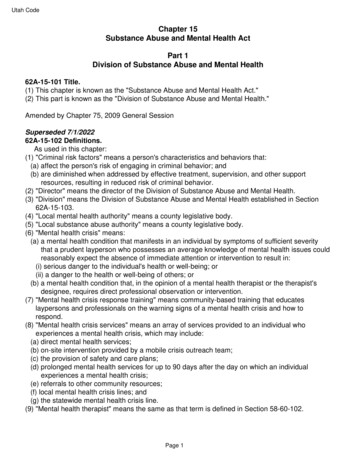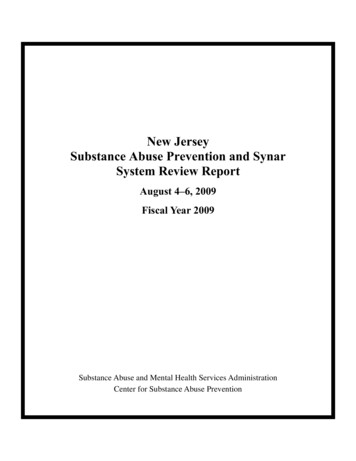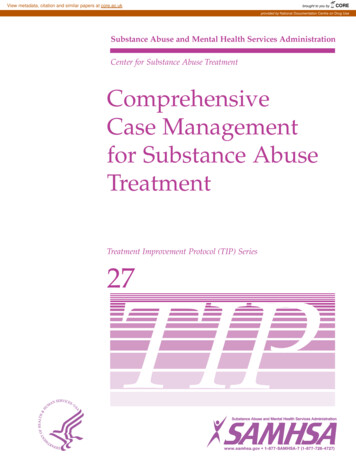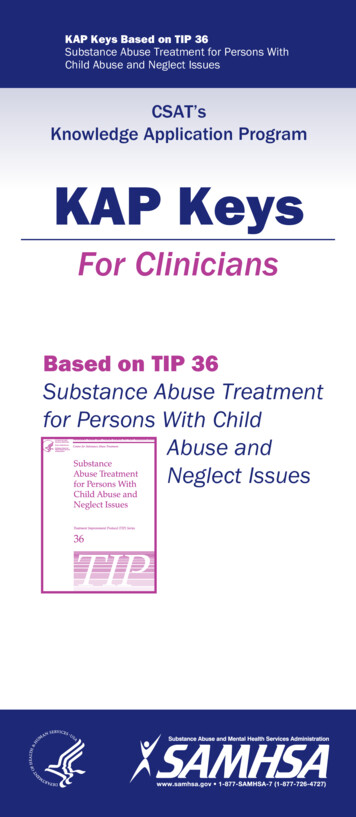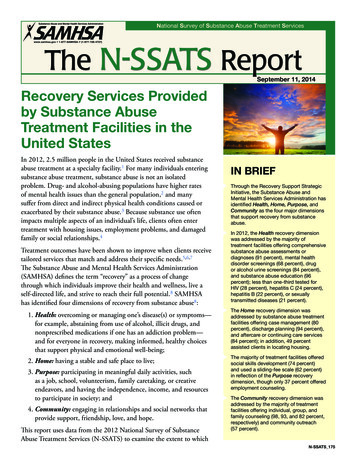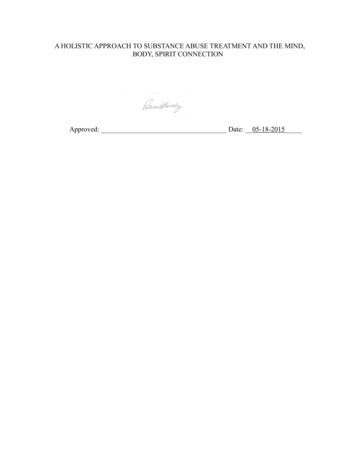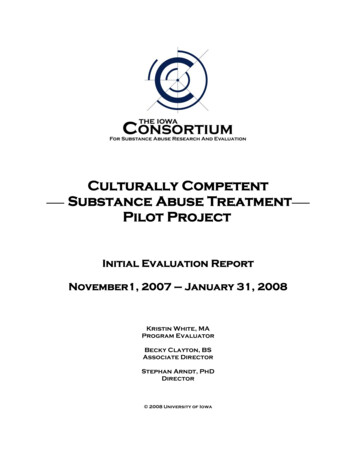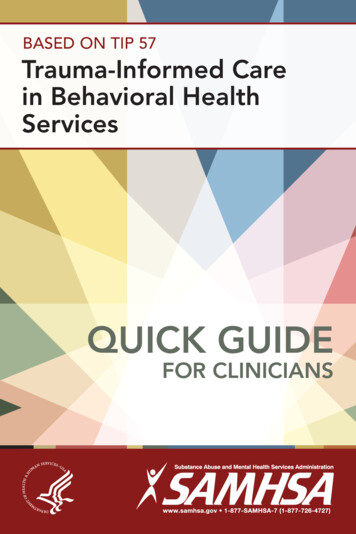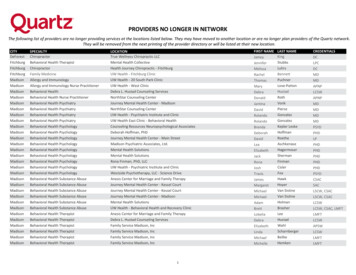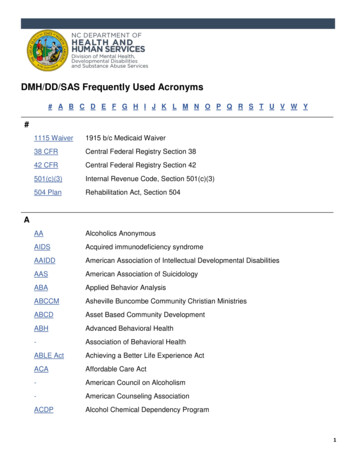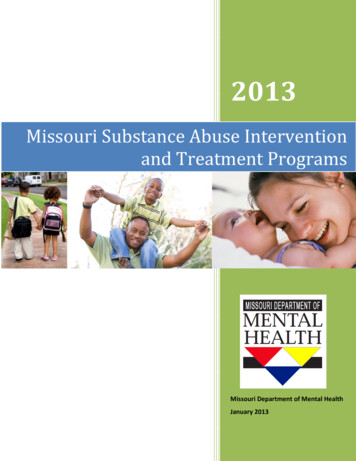
Transcription
2013Missouri Substance Abuse Interventionand Treatment ProgramsMissouri Department of Mental HealthJanuary 2013
Missouri Substance Abuse Intervention and Treatment ProgramsAbout the ProgramsIn Missouri, the Department of Mental Health (DMH) is the state authority responsible for developing and implementinga statewide response addressing substance abuse problems impacting Missouri families and communities. DMHprovides intervention, treatment, and recovery support services through contracted community-based and faith-basedservice providers. DMH works closely with the Department of Social Services for the coordination of services for thestate’s Medicaid population and with the Department of Corrections for the coordination of services for the supervisedoffender population.Authorization for ProgramsRSMo 631.010 and 191.831 for substance abuse treatment programs and RSMO 577.049, 577.520 and 631.010 for thesubstance abuse traffic offenders program.FundingSubstance abuse treatment programs are funded by about 30 million in state general revenue which generates anadditional 49 million in matched federal funding including Medicaid and Substance Abuse Prevention and TreatmentBlock Grant.Prevalence of Substance Abuse in MissouriGeneral Population: Approximately 394,000 Missourians struggle with a substance abuse disorder. Of these,33,000 are between the ages of 12 and 17 (SAMHSA, 2012a).Community-Supervised Offender Population: In Missouri, approximately 15,400 parolees and 34,600probationers need substance abuse treatment (Missouri Department of Corrections, 2012).Veterans Population: Of the approximately 543,000 Missouri Veterans, an estimated 7.3 percent or 39,600have a substance abuse problem (Missouri Department of Public Safety, 2012; SAMHSA, 2012b).Pregnant Women: Of the approximately 86,900 pregnancies in the state, about 6,800 are women who arestruggling with an alcohol or drug problem (SAMHSA, 2012b).Number ServedSpecial PopulationsServed in ADA Substance Abuse Treatment Programs in FY 2012: 840 Pregnant women3,000 Adolescents2,958 Veterans23,593 Community-supervised offenders on probation or parole2,584 Homeless Missourians12,886 Parents with dependent children922 Drug Court participants15,020 Individuals with a co-occurring mental illness (6,715 with a serious mental illness)18,198 Medicaid enrollees, including 9,048 partially or totally disabledMissouri Department of Mental HealthPage 2
Missouri Substance Abuse Intervention and Treatment ProgramsNumber Served in ADA Programs100,00075,00050,00025,0000FY 2010FY 2011FY 2012Substance Abuse Treatment46,27443,10941,951Recovery Supports10,0493,4404,965Traffic Offenders Program35,98230,53131,670*Recovery Supports are funded through the federal Access to Recovery (ATR) III grant. FY 2011 was a transition yearbetween ATR II and ATR III grants. In FY 2011, funding reductions occurred with the federal ATR program and stategeneral revenue. The Substance Abuse Traffic Offenders’ Program is largely funded through offender fees. SubstanceAbuse Treatment is funded through a combination of state and federal funding.Evidence of EffectivenessInstitutional plus Community-Based Treatment Produces Less Re-IncarcerationResearch has shown that substance abuse treatment during and after incarceration reduces re-incarceration rates(National Institute on Drug Abuse, 2012). Missouri’s data shows that offenders who complete both institutional andcommunity-based substance abuse treatment have the lowest re-incarceration rate compared to those who did notcomplete institutional treatment or community-based treatment or did not receive any treatment but neededtreatment.Percent that Return to Prison within 1 Year of 10.00%5.4%0.00%CompletedInstitutionalTreatment andCommunityTreatmentNo InstitutionalTreatment butCompletedCommunityTreatmentInstitutionalNo Treatment butCompletedTreatment but No Needed Treatment Institutional butCommunityDropped Out ofTreatmentCommunityTreatmentNo InstitutionalTreatment butDropped Out ofCommunityTreatmentData source: Matched records from DOC and DMH information systems for offenders released from prison in FY 2011.Missouri Department of Mental HealthPage 3
Missouri Substance Abuse Intervention and Treatment ProgramsMedication Assisted Treatment Prior to Release from PrisonDMH is working with the Department of Corrections to implement a pilot project involving medication assistedtreatment at Ozark Correctional Center in Fordland. Approximately 50 individuals who are returning to the St. Louisarea and volunteer to participate will receive one injection of Vivitrol 3 to 4 days prior to their release. Vivitrol blocksopiate receptors in the brain thereby eliminating the euphoric effects and preventing cravings for alcohol and opiatedrugs such as heroin. It is administered in the form of a shot once per month. These individuals will receive follow-upmedication and substance abuse counseling through DMH contracted community agencies in St. Louis. It is anticipatedthat these individuals will be less likely to relapse to alcohol or opiate use upon their release from prison, therebyreducing the likelihood of re-arrest and re-incarceration. The University of Missouri-St. Louis, Missouri Institute ofMental Health will be conducting the project evaluation.Community-Based Treatment is Cheaper than IncarcerationThe potential cost savings from community-based substance abuse treatment in lieu of incarceration has beenrecognized in several large-scale studies including the California Treatment Outcome Project and the National TreatmentImprovement Evaluation Study (Ettner, S.L. & et al., 2006; SAMHSA, 1997). In Missouri, the average prison stay for anoffender with a drug-related offense is 333 days at an average cost of 57.18 per day - yielding an average cost per stayof 19,041. The average length of engagement in community-based treatment is 81 days with an average cost of 1,771. Intervention fees collected from offenders help pay a portion of the cost for community corrections andintervention services for offenders under community supervision. 20,000Incarceration vs. Treatment:Average Cost per Person in FY 2012 10,000 0Average Cost per Person in FY 2012IncarcerationCommunity-BasedSubstance AbuseTreatment 19,041 1,771Data source: DOC and DMH billing systems.Missouri Department of Mental HealthPage 4
Missouri Substance Abuse Intervention and Treatment ProgramsTreatment for Pregnant Women Increases Likelihood of Healthy BabiesAccording to the National Household Survey on Drug Use and Health, approximately 5.5 percent of pregnant womenhave an alcohol addiction problem, and 1.2 percent of pregnant women have an illicit drug problem (SAMHSA, 2012c).Research has shown that pregnant women who need and receive substance abuse treatment are more likely to receiveprenatal care; are more likely to reduce or abstain from alcohol, drugs, and tobacco use; and have better perinataloutcomes (Brady, T.M. & Ashley, O.S., 2005). Better outcomes are obtained for women who enter treatment early intheir pregnancy. Lifetime cost of a child born with Fetal Alcohol Syndrome is estimated at 2 million (SAMHSA, 2012d).Drug-Free Births in CSTAR Programs300250200150100500FY 2010FY 2011FY 2012Total Babies Born222248257Babies Born Drug-Free191170179Data source: Treatment Episode Dataset, DMH information system.Drug Testing in the Opioid ProgramsThere is considerable research that shows that Opioid Treatment can reduce: illicit drug use, including injection druguse; risk of overdose; risky sexual behavior; transmission of infectious diseases (i.e. HIV, hepatitis B or C, bacterialinfections); and criminal activity in addition to improving pregnancy outcomes (CDC, 2002). Most individuals inMissouri’s Opioid Treatment programs do not test positive for illicit drugs when subjected to random drug tests.Percent of Negative Drug Tests for the CSTAR Opioid Program100%75%50%25%0%No Illegal Drug UseFY 2010FY 2011FY 201269%71%75%Data source: Results of random drug tests collected from contracted agencies.Missouri Department of Mental HealthPage 5
Missouri Substance Abuse Intervention and Treatment ProgramsDWI RecidivismIn Missouri, completion of the Substance Abuse Traffic Offender Program (SATOP) is a required element of driver licensereinstatement. Research has shown that combining alcohol treatment with either driver license restriction orsuspension is associated with lower DWI recidivism rates compared to other interventions such as jail (DeYoung, D. J.,1997). Most individuals who complete SATOP do not receive an additional DWI five years post-graduation. Of thosethat graduated during FY 2007, 85.2 percent have not re-offended by FY 2012.No DWI within 5 years of SATOP Completion100.0%75.0%50.0%25.0%0.0%Percent without a DWI 5-years postgraduationFY 2005FY 2006FY 200784.8%84.5%85.2%Data source: SATOP data, DMH information system.Recently, the SATOP program has added an intensive treatment component for chronic, repeat offenders participatingin Drug/DWI Court. A Michigan study found that DWI Court with treatment significantly reduced re-arrest whencompared to DWI offenders on traditional probation. One year re-arrest rates were 4.3 percent for DWI Courtparticipants vs. 15.2 percent for offenders on traditional probation (NPC Research, 2008). In Missouri’s Serious andRepeat Offender Program, 2 or 4.26 percent of the 47 FY 2011 graduates re-offended within a one year period. This iscomparable to the results obtained in the Michigan Study.Treatment RecidivismWhile relapse is a common characteristic of the addiction process, most DMH consumers do not cycle in and out ofsubstance abuse treatment.Percent Not Re-Admitted to Treatment within One Year of Discharge100.0%75.0%50.0%25.0%0.0%Percent Not Re-Admitted within OneYearFY 2009FY 2010FY 201172.4%74.0%74.5%Data source: FY 2009-FY 2011 Treatment Discharges, DMH information system.Missouri Department of Mental HealthPage 6
Missouri Substance Abuse Intervention and Treatment ProgramsTransition from Detox to Treatment Increases Likelihood of SuccessFrom SAMHSA’s Detoxification and Substance Abuse Training Manual:Detox patients are in a crisis.Research shows that detox is often followed by a reduction in drug use and a desire to seek treatment.Linkage from detox to treatment leads to an increase in recovery and a decrease in repeated detox andtreatment services.Success at recovery depends on continuation of treatment after detox (SAMHSA, 2009).Percent Transitioning from Detox to Treatment40%20%0%Percent Tranitioning from Detox toTreatmentDMHProgramsMissouriHospitalsU.S. PubliclyFundedPrograms34.1%5.6%10.8%Data source: 2009 Treatment Episode Dataset (SAMHSA, 2012e); Missouri hospital data based on Medicaid patientsserved in FY 2011 who are admitted to substance abuse treatment within 5 days of hospital discharge as determinedfrom Medicaid claims.Adolescent School AchievementIntervention and treatment is important for substance-using adolescents. Research suggests that substance use mayimpair cognitive development – particularly for heavy substance use. In addition, the association between substanceuse and antisocial peer groups may reduce school engagement (King, K.M., Meehen, B.T., Trim, R.S., & Chassin, L., 2006.)Missouri’s CSTAR Adolescent Program addresses academic education in the treatment process.Percent of Students who Have an Average GPA of "C" or Betterfor CSTAR Adolescent Program100%75%50%25%0%Percent with Average GPA of "C" orBetterAdmissionDischarge66%73%Data source: Treatment Episode Dataset, DMH information systemMissouri Department of Mental HealthPage 7
Missouri Substance Abuse Intervention and Treatment ProgramsSchool-Based InterventionMissouri’s School-Based Prevention Program (SPIRIT Program) operates in five school districts that serve at-risk studentpopulations based on standardized test scores, graduation rates, substance use prevalence, and juvenile justicereferrals. SPIRIT’s program goals are to: 1) delay onset and decrease use of alcohol, tobacco and other drugs; 2) improveoverall school performance, and 3) reduce incidents of violence, including bullying. Students who participate in theevidence-based SPIRIT program have lower rates of substance use compared that for students statewide.Missouri's School-Based SPIRIT Programto Reduce Recent Substance 3%6.4%3.4%U.S.8.9%14.7%7.3%1.0%Data source: SPIRIT Evaluation (2011), Missouri Institute for Mental Health; Missouri Student Survey (2010); NationalSurvey on Drug Use and Health (2009)Reducing Binge Drinking at Missouri CollegesBinge drinking has been associated with unintentional and intentional injuries, alcohol poisoning, sexually transmitteddiseases, unintended pregnancy, and children born with Fetal Alcohol Spectrum Disorders (CDC, 2012). Funded in partby DMH, Partners in Prevention is a statewide coalition of 13 public and 9 private universities whose mission is to createan environment that supports good decision making in regards to alcohol by the college students who attend the highereducation institutions in Missouri. In recent years, the prevalence of binge drinking among Missouri college studentshas declined.Binge Drinking by Missouri College Students40%20%0%Percent Binge Drinking in Past 30 DaysFY 2006FY 2007FY 2008FY 2009FY 2010FY 2011FY 201240%34%30%36%32%31%26%Data source: Missouri College Health Behavior Survey, Partners in Prevention (PIP) ProgramMissouri Department of Mental HealthPage 8
Missouri Substance Abuse Intervention and Treatment ProgramsReferencesBrady, T.M. & Ashley, O.S. (2005). Women in substance abuse treatment: Results from the Alcohol and Drug ServicesStudy (ADSS) (DHHS Publication No. SMA 04-3968, Analytic Series A-26). Rockville, MD: Substance Abuse andMental Health Services Administration, Office of Applied Studies.Centers for Disease Control and Prevention (2002). Methadone Maintenance Treatment. Retrieved enters for Disease Control and Prevention (2012). Fact Sheet: Binge Drinking. Retrieved inking.htm.Deyoung, D.J. (1997). “An Evaluation of the Effectiveness of Alcohol Treatment, Driver License Actions and Jail Terms inReducing Drunk Driving Recidivism in California.” Addiction 92(8), 989-997.Ettner, S.L. & et al (2006). "Benefit-Cost in the California Treatment Outcome Project: Does Substance Abuse Treatment'Pay for Itself'?" Health Services Research 41(1):192-213.King, K.M., Meehen, B.T., Trim, R.S., & Chassin, L. (2006). “Substance Use and Academic Outcomes: SynthesizingFindings and Future Directions.” Addiction 101(12):1688-1689.Missouri Department of Corrections (2012). A Profile of the Institutional and Supervised Offender Population on June30, 2011. Retrieved at: 20Profile%20FY11.pdf.Missouri Department of Public Safety (2012). Veterans Service Program [website]. Retrieved at:http://www.mvc.dps.mo.gov/service/.National Institute on Drug Abuse (2012). Principles of Drug Abuse Treatment for Criminal Justice Populations: AResearch-Based Guide. Retrieved at: http://www.drugabuse.gov/sites/default/files/podat cj 2012.pdf.NPC Research (2008). Michigan DUI Courts Outcome Evaluation: Final Report. Retrieved at:http://www.npcresearch.com/Files/MI DUI Outcome Evaluation FINAL REPORT ReRelease March 2008.pdf.Substance Abuse and Mental Health Services Administration (1997) National Treatment Improvement Evaluation Study1997 Highlights.Substance Abuse and Mental Health Services Administration (2001) Youth Violence Linked to Substance Use. TheNHSDA Report. Retrieved at: .htm.Substance Abuse and Mental Health Services Administration (2009). Detoxification and Substance Abuse TreatmentTraining Manual: Based on A Treatment Improvement Protocol TIP 45. Retrieved iculums/pdfs/tip45 curriculum.pdf.Substance Abuse and Mental Health Services Administration (2012a). 2009-2010 NSDUH State Estimates of SubstanceUse and Mental Disorders. Retrieved Hsae2010/Index.aspx.Missouri Department of Mental HealthPage 9
Missouri Substance Abuse Intervention and Treatment ProgramsSubstance Abuse and Mental Health Services Administration (2012b). National Survey on Drug Use and Health: 8-YearRestricted-use Data Analysis System (2002 to 2009) [dataset]. Retrieved HDA/rdas.html.Substance Abuse and Mental Health Services Administration (2012c). National Survey on Drug Use and Health, 2011[dataset]. ICPSR34481-v1. Ann Arbor, MI: Inter-university Consortium for Political and Social Research[distributor], 2012-11-28. doi: 10.3886/ICPSR34481.v1.Substance Abuse and Mental Health Services Administration (2012d). The Financial Impact of Fetal Alcohol Syndrome[website]. Accessed on January 12, 2013 at: x.Substance Abuse and Mental Health Services Administration (2012e). Treatment Episode Data Set, Dishcharges, 2009[dataset]. ICPSR33621-v1. Ann Arbor, MI: Inter-university Consortium for Political and Social Research[distributor], 2012-10-25. Doi:10.3886/ICPSR33621.v1.Missouri Department of Mental HealthPage 10
have a substance abuse problem (Missouri Department of Public Safety, 2012; SAMHSA, 2012b). Pregnant Women: Of the approximately 86,900 pregnancies in the state, about 6,800 are women who are struggling with an alcohol or drug problem (SAMHSA, 2012b). Number Served Special Populations Served in ADA Substance Abuse Treatment Programs in FY 2012:
